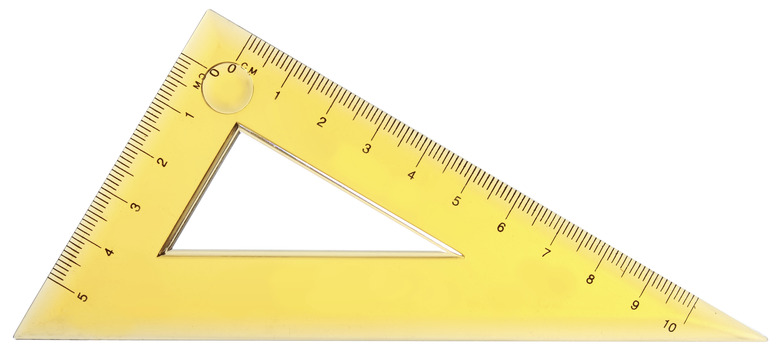How To Find The Perimeter Of A Right Triangle
The perimeter of a shape is the length around the outside of that shape. **Because a triangle's outside is composed of three lines, you can find its perimeter by adding the lengths of these lines.** If you know only the lengths of two sides of a right triangle, you can use the Pythagorean Theorem to find the length of the third side.
Adding Sides to Find Perimeter
Adding Sides to Find Perimeter
**A triangle has three sides, a, b, and c.** To find the perimeter, **P,** add the lengths of these sides:
P = a + b + c
Say you have a right triangle whose three sides are 3 inches, 4 inches and 5 inches. To find the perimeter, add 3, 4 and 5.
P = 3 + 4 + 5 P = 12
So, your triangle has a perimeter of 12 inches.
The Pythagorean Theorem
The Pythagorean Theorem
**The Pythagorean Theorem is a formula that shows the relationship between the lengths of a right triangle's sides.**
a^2 + b^2 = c^2
Sides *a and b are the triangle's two legs** – which meet to form the triangle's right angle. Side c is the hypotenuse*,** the side opposite the right angle.
You can take a triangle where you know two sides, and use the Pythagorean Theorem find the length of the third. Say your triangle's two legs are 3 inches and 4 inches long, so a is 3, and b is 4:
c^2 = 3^2 + 4^2 = 9 + 16 = 25
You now can solve for the length of the hypotenuse by taking the square root of both sides. The square root of a number is the number that, multiplied by itself, produces that number. **The square root of c^2 is c, and the square root of 25 is 5.** You now know that side c is 5 inches long, so you can find the perimeter by totaling the three side lengths.
P = 3 inches + 4 inches + 5 inches = 12 inches
So this triangle has a perimeter of 12 inches.
Theorem to Find Other Sides
Theorem to Find Other Sides
You can also use the Pythagorean Theorem to find the length of a triangle's leg if you know the length of the other leg and the hypotenuse. In this case, the square of the unknown leg is equal to the square of the hypotenuse minus the square of the known leg:
c^2 – a^2 = b^2
Take a triangle with a hypotenuse of 15 inches and one leg of 9 inches. You can find b^2 using the formula above:
b^2 = 15^2 – 9^2 = 225 – 81 = 144
So b^2 equals 144, which means b equals the square root of 144. The square root of 144 is 12, so leg b is 12 inches long. You can now add up the sides to find perimeter:
P = 9 inches + 15 inches + 12 inches = 36 inches
So the triangle has a 36-inch perimeter.
Cite This Article
MLA
Zamboni, Jon. "How To Find The Perimeter Of A Right Triangle" sciencing.com, https://www.sciencing.com/perimeter-right-triangle-6196682/. 24 April 2017.
APA
Zamboni, Jon. (2017, April 24). How To Find The Perimeter Of A Right Triangle. sciencing.com. Retrieved from https://www.sciencing.com/perimeter-right-triangle-6196682/
Chicago
Zamboni, Jon. How To Find The Perimeter Of A Right Triangle last modified March 24, 2022. https://www.sciencing.com/perimeter-right-triangle-6196682/
